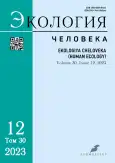Влияние сезонных колебаний температуры и социальных факторов на распространение малярии
- Авторы: Аракельян Р.С.1, Маслянинова А.Е.2, Еранцева В.А.1, Зейналова Г.Р.1, Худари Ю.М.1
-
Учреждения:
- Астраханский государственный медицинский университет
- Детская городская поликлиника № 4
- Выпуск: Том 30, № 12 (2023)
- Страницы: 919-928
- Раздел: ОРИГИНАЛЬНЫЕ ИССЛЕДОВАНИЯ
- URL: https://journals.rcsi.science/1728-0869/article/view/262167
- DOI: https://doi.org/10.17816/humeco603702
- ID: 262167
Цитировать
Полный текст
Аннотация
Цель. Ретроспективный анализ распространённости эпизодов малярии на территории Астраханской области за 2002–2022 гг., связанной с климатическими и социальными факторами, с целью повышения эффективности проводимых профилактических мероприятий.
Материал и методы. В ходе обсервационного исследования определяли корреляцию между распространением малярии и климатическими, а также социальными факторами за 2002–2022 гг. на территории Астраханской области. Исследование проводили круглогодично. Анализ климатических и социальных данных выполняли на основании статистической обработки отчётных форм Центра гигиены и эпидемиологии в Астраханской области, а также по данным, предоставленным Роспотребнадзором по Астраханской области. Статистическую обработку полученных данных проводили с использованием Microsoft Office Exсel (Microsoft, США) и Bio Stat Professional 5.8.4.
Результаты. Снижение эпизодов малярии в Астраханской области является положительной тенденцией, которая свидетельствует о важности и эффективности мер по борьбе с этой опасной болезнью.
Заключение. Необходимо продолжать работу в этом направлении, чтобы обеспечить безопасность и благополучие населения региона в связи с регистрирующимися завозными случаями малярии.
Ключевые слова
Полный текст
Открыть статью на сайте журналаОб авторах
Рудольф Сергеевич Аракельян
Астраханский государственный медицинский университет
Автор, ответственный за переписку.
Email: rudolf_astrakhan@rambler.ru
ORCID iD: 0000-0001-7549-2925
SPIN-код: 9245-8543
кандидат мед. наук, доцент
Россия, 414000, Астрахань, ул. Бакинская, 121Анна Евгеньевна Маслянинова
Детская городская поликлиника № 4
Email: rudolf_astrakhan@rambler.ru
ORCID iD: 0000-0003-0908-950X
SPIN-код: 1981-3406
Врач-педиатр
Россия, АстраханьВалерия Алексеевна Еранцева
Астраханский государственный медицинский университет
Email: vyerantseva@bk.ru
ORCID iD: 0000-0001-5065-7260
студентка 5-го курса
Россия, 414000, Астрахань, ул. Бакинская, 121Гевхер Руслановна Зейналова
Астраханский государственный медицинский университет
Email: gevherzeinalova16@mail.ru
ORCID iD: 0000-0002-6660-8073
SPIN-код: 4453-0368
студентка 6-го курса
Россия, 414000, Астрахань, ул. Бакинская, 121Юлия Мохамад Салех Худари
Астраханский государственный медицинский университет
Email: yullia.kh.sr@gmail.com
ORCID iD: 0009-0003-7445-7441
SPIN-код: 2661-6493
студентка 5-го курса
Россия, 414000, Астрахань, ул. Бакинская, 121Список литературы
- World Malaria Report 2021 [Internet]. World Health Organization; 2021 Available from: https://www.who.int/teams/global-malaria-programme/reports/world-malaria-report-2021
- Robert V., Macintyre K., Keating J., et al. Malaria transmission in urban sub-Saharan Africa // Am J Trop Med Hyg. 2003. Vol. 68, N 2. P. 169–176.
- Sachs J., Malaney P. The economic and social burden of malaria // Nature. 2002. Vol. 415, N 6872. P. 680–685. doi: 10.1038/415680a
- Worrall E., Rietveld A., Delacollette C. The burden of malaria epidemics and cost-effectiveness of interventions in epidemic situations in Africa // Am J Trop Med Hyg. 2004. Vol. 71, 2 Suppl. P. 136–140.
- Алексеев А.Н. Возможные последствия вероятного глобального потепления климата для распространения кровососущих эктопаразитов и передаваемых ими патогенов // Медицинская паразитология и паразитарные болезни. 1998. № 4. С. 3–8.
- Аракельян Р.С., Галимзянов Х.М., Аракельян А.С., Шендо Г.Л. Ретроспективный анализ эпидемиологических очагов при малярии в Астраханской области. В кн.: Профилактическая медицина как научно-практическая основа сохранения и укрепления здоровья населения Сборник научных трудов / под общей ред. М.А. Поздняковой. Нижний Новгород, 2014. С. 100–103. EDN: TOKJXT
- Аракельян Р.С., Сало А.А., Ибрагимова С.А. Случаи завозной малярии в Астрахани // Новая наука: опыт, традиции, инновации. 2016;(5-3):63–66. EDN: VXNBRT
- Иванова Т.Н. Малярия в условиях мегаполиса: автореф. дис. … канд. мед. наук. М., 2006. 25 с. EDN: FNHMNP
- Kundzevich Z.V. Extreme hydrological phenomena: heavy precipitation, floods and droughts. In: World Conference on Climate Change. Proceedings of the conference. Moscow; 2004. P. 240–247.
- Ревич Б.А., Малеев В.В. Потепление климата — возможные последствия для здоровья населения. В кн.: Климатические изменения: взгляд из России. М.: ТЕИС, 2003. С. 99–137. EDN: QKDXUR
- Yamana T.K., Eltahir E.A. Incorporating the effects of humidity in a mechanistic model of Anopheles gambiae mosquito population dynamics in the Sahel region of Africa // Parasit Vectors. 2013. Vol. 6. P. 35. doi: 10.1186/1756-3305-6-235
- Ранькова Э.Я. Климатическая изменчивость и изменения климата за период инструментальных наблюдений: автореф. дис. … д-ра физ.-мат. наук. М., 2005. 67 с. EDN: NIIWLH
- Smith D.L., McKenzie F.E. Statics and dynamics of malaria infection in Anopheles mosquitoes // Malar J. 2004. Vol. 3. P. 13. doi: 10.1186/1475-2875-3-13
- Killeen G.F., McKenzie F.E., Foy B.D., et al. A simplified model for predicting malaria entomologic inoculation rates based on entomologic and parasitologic parameters relevant to control // Am J Trop Med Hyg. 2000. Vol. 62, N 5. P. 535–544. doi: 10.4269/ajtmh.2000.62.535
- President’s Malaria Initiative U.S. Rwanda: 2017 Entomological Monitoring, July 2016–June 2017. Final Report. Kigali, Rwanda: VectorLink Project, Abt Associates Inc.; 2017.
- Vector resistance to pesticides. Fifteenth Report of the WHO Expert Committee on Vector Biology and Control // World Health Organ Tech Rep Ser. 1992. Vol. 818. P. 1–62.
- Cтулова Т.В., Бородкова А.А., Узбякова Р.Р. Климат — как причина распространения малярии в Астраханской области // Новая наука: от идеи к результату. 2016. № 6–2. С. 26–30. EDN: WGQFPF
- Миронова В.А., Шартова Н.В., Варенцов М.И., Грищенко М.Ю. Пространственно-временные тренды изменений климатических условий для развития возбудителя трехдневной малярии в Московском регионе // Паразитология. 2019. Т. 53, № 2. С. 105–119. EDN: ZGZPXN doi: 10.1134/S0031184719020029
- Малхазова С.М., Шартова Н.В. Малярия на Европейской территории России в 21-м веке: опыты прогнозирования // Теоретическая и прикладная экология. 2012. № 3. С. 19–23. EDN: PYFYDD









